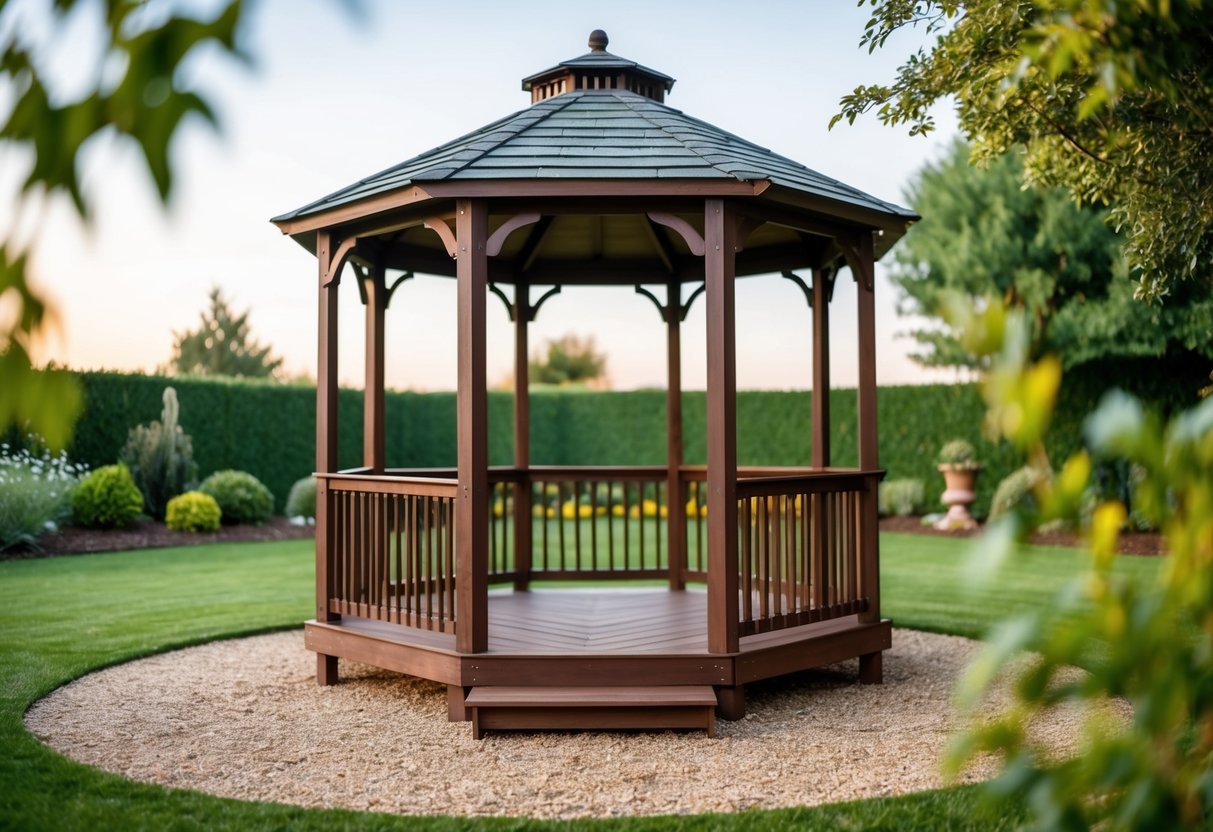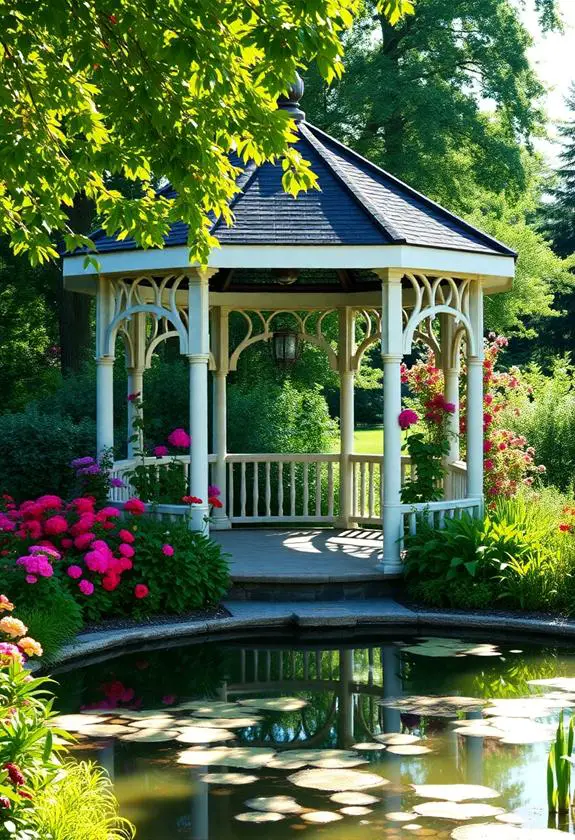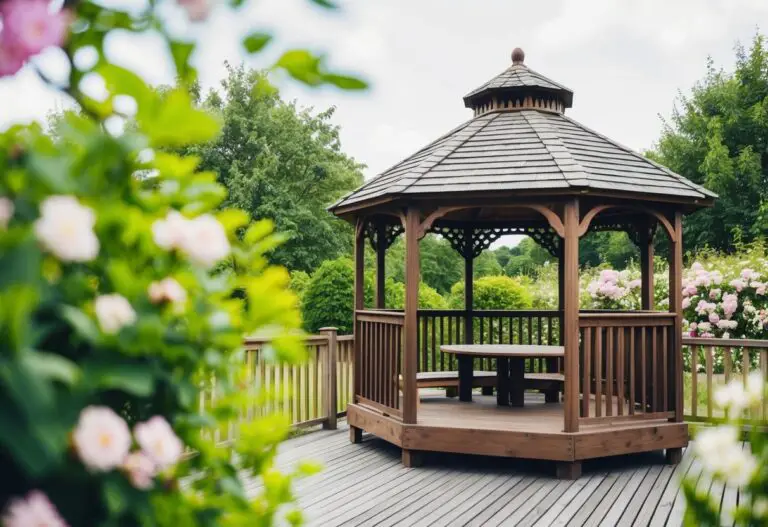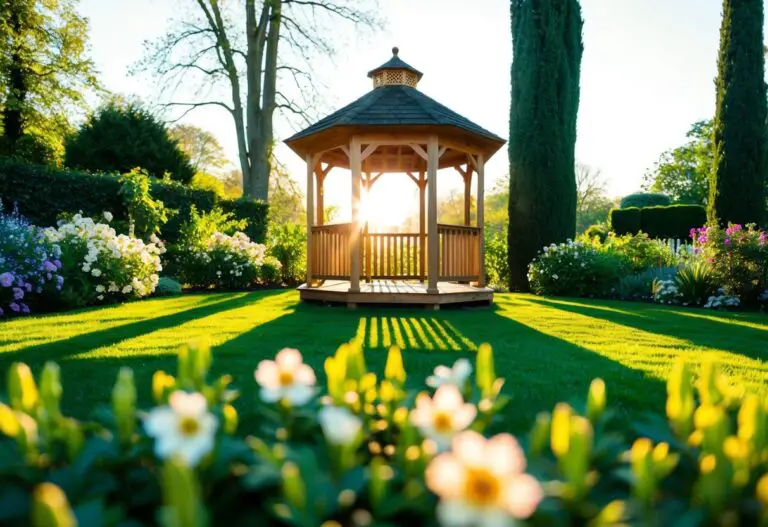Gazebos add beauty and function to your outdoor space. They provide shade and shelter for relaxing or entertaining. But have you ever wondered if these structures need to be secured? Gazebos should be anchored for safety and stability, especially larger ones or those with metal frames. This step is crucial to prevent them from tipping over in strong winds or storms.

Anchoring your gazebo isn’t just about safety. It also helps keep your outdoor oasis in top shape for years to come. By securing it properly, you’ll avoid damage to the structure and ensure it stays put during all kinds of weather.
Key Takeaways
- Anchoring is essential for gazebo safety and longevity
- The anchoring method depends on the gazebo type and surface
- Proper anchoring prevents damage and accidents in harsh weather
Why Anchoring Is Important
Anchoring your gazebo is crucial for your safety and enjoyment. Without proper anchoring, your beautiful outdoor structure could become a hazard in windy conditions.
Think about those blustery days when the wind picks up suddenly. An unsecured gazebo might wobble, shake, or even topple over! By anchoring it securely, you protect yourself and your guests from potential accidents.
Stability is key for any outdoor structure. A well-anchored gazebo stays put, giving you peace of mind no matter the weather. You won’t have to worry about it shifting or moving during your outdoor gatherings.
Strong winds and heavy rain can really test your gazebo’s strength. When it’s properly anchored, your gazebo can withstand these challenges much better. It won’t budge, keeping you dry and comfortable inside.
Here are some benefits of a securely anchored gazebo:
- Stays in place during storms
- Protects you from flying debris
- Maintains its shape and structure
- Lasts longer due to less stress on the frame
Remember, different surfaces need different anchoring methods. Grass, concrete, and wooden decks all require specific approaches to keep your gazebo stable and secure.
Factors To Consider
When thinking about anchoring your gazebo, size matters. Bigger gazebos need stronger anchoring to stay put. The material of your gazebo is also important. Metal ones might need extra-sturdy anchors to keep them grounded.
Where you put your gazebo affects how you anchor it. Is it on grass, concrete, or pavers? Each surface needs a different approach. Soft ground like grass is easier to stake into, while concrete might need special anchors.
Weather plays a big role too. If you live in a windy area, you’ll want to make sure your gazebo is extra secure. Heavy rain or snow can also put stress on your structure.
Don’t forget about the soil type in your backyard. Sandy soil might not hold stakes as well as clay. If you’re unsure, a simple soil test can help you choose the right anchoring method.
Regular checks are key. Look for loose bolts or signs of wear. This helps catch small issues before they become big problems. A little care goes a long way in keeping your gazebo safe and sturdy for years to come.
Types of Anchors
You have many options for anchoring your gazebo. Ground anchors are great for grass or soil. These screw-in devices provide a solid hold without much fuss.
Concrete footings offer a more permanent solution. They’re perfect if you want your gazebo to stay put for years to come.
For a quick fix, try tie-down straps. These are handy for temporary setups or when you need to move your gazebo often.
Sandbags and weighted bags can work well too. They’re easy to use and don’t damage your deck or patio.
Anchor bolts are strong choices for concrete surfaces. They keep your gazebo steady in windy weather.
Here’s a simple list of anchor types:
- Auger anchors
- Concrete anchors
- Ground stakes
- Screw-in anchors
- Weighted bags
Remember, the best anchor for you depends on where you put your gazebo and how long you want it to stay there. Pick the type that fits your needs and keeps your gazebo safe and stable.
Steps To Anchor A Gazebo
First, look at your gazebo and where it sits. Think about what kind of ground it’s on – grass, concrete, or pavers. This will help you pick the right way to anchor it.
Next, get the area ready. Remove any rocks or debris. Make sure the ground is flat. This helps your gazebo stay level and stable.
Now it’s time to install the anchors. If you’re on grass, you can use steel stakes. Drive them into the ground at each corner of the gazebo. Aim for a 45-degree angle to make them extra strong.
For concrete or pavers, you’ll need to drill holes. Use a hammer drill to make holes where you want the anchors. Clean out the dust with a vacuum.
Put the anchors in the holes you made. Tap them in gently with a hammer. Make sure they’re flush with the ground.
Finally, attach your gazebo to the anchors. Use bolts or straps to connect the gazebo legs to the anchors. Check that everything is tight and secure.
Remember to follow any instructions that came with your gazebo or anchors. Different types might need slightly different steps.
Benefits Of Proper Anchoring
Anchoring your gazebo properly comes with several advantages. Let’s look at why it’s so important to secure your outdoor structure.
First and foremost, anchoring increases stability. When you anchor your gazebo, it stays put even in strong winds or heavy rain. This means you can relax and enjoy your outdoor space without worrying about your gazebo tipping over.
Safety is another big plus. A well-anchored gazebo is less likely to cause accidents or damage. You won’t have to worry about it falling on people or property during bad weather.
Proper anchoring also helps your gazebo last longer. By keeping it secure, you prevent wear and tear from constant movement. This means your gazebo will stay in good shape for years to come.
Here are some key benefits of anchoring your gazebo:
- Protects against wind damage
- Prevents tipping or collapse
- Reduces risk of injury
- Extends the life of your gazebo
- Gives you peace of mind
By taking the time to anchor your gazebo, you’re making a smart investment in your outdoor living space. You’ll be able to enjoy your gazebo more knowing it’s safe and secure.
Maintenance Tips
Keeping your gazebo anchored isn’t a one-time task. You need to check on it regularly to make sure it stays safe and secure.
Take a look at your gazebo’s anchors every few months. Give them a good once-over to see if anything looks loose or worn out.
If you spot any wobbly parts, it’s time to grab your tools. Tighten up those anchors to keep your gazebo sturdy.
Don’t forget about the weather! Rain and moisture can be tough on metal parts. Use some rust-resistant spray on your anchors to keep them in good shape.
Here’s a quick checklist to help you out:
- Check anchor bolts and straps
- Tighten any loose parts
- Look for signs of rust or wear
- Apply weatherproofing products as needed
By staying on top of these simple tasks, you’ll help your gazebo stand strong for years to come. It only takes a few minutes, but it can save you a lot of trouble down the road.
Remember, a well-anchored gazebo is a safe gazebo. Your outdoor space will thank you for the extra care!
Frequently Asked Questions
Gazebo anchoring is important for safety and stability. There are various methods to secure gazebos on different surfaces, including options that don’t require drilling.
What are some effective methods for anchoring a gazebo without drilling?
You can use weighted bags filled with sand or gravel to anchor your gazebo. Place these bags on each leg or corner for added stability.
Another option is to use heavy planters. Fill large pots with soil and plants, then position them around the gazebo base.
Tie-down straps are also useful. Attach them to the gazebo frame and secure them to heavy objects like concrete blocks or large rocks.
Can you provide guidance on securing a gazebo to a grass surface?
For grass surfaces, you can use spiral ground anchors. These screw into the soil and attach to the gazebo frame with straps or cables.
Stake anchoring is another effective method. Drive heavy-duty steel stakes into the ground at each corner of the gazebo.
Consider using a combination of stakes and guy wires for extra security. This helps distribute the force and keeps your gazebo stable.
Are there special considerations for anchoring a wooden gazebo compared to other materials?
Wooden gazebos are often heavier than metal ones, which can help with stability. Still, they need proper anchoring.
You can use concrete footings for a permanent solution. Dig holes at each corner and fill them with concrete to create a solid base.
For less permanent options, consider using L-brackets. These attach to the wooden frame and can be secured to the ground or a deck.
Remember to check the gazebo’s stability regularly, especially after strong winds or storms.





